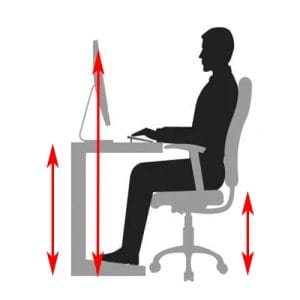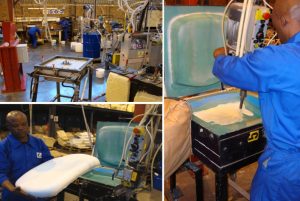
What is the correct ergonomic height for my desk, computer monitor and office chair?
Correct height settings for sitting and standing at work
Although nobody can predict the future with absolute certainty, what we can say is that since the advent of Covid-19, the "world of work" has changed. The old way no longer exists and hoping that "things will return to (pre-Covid) normal", is but a dream. Businesses and the way we work has changed. Permanently. If we now try to look ahead, what is the future of work in South Africa and around the globe, and how will it impact us? What jobs will change and what new skills will be required? How will our workplaces look, and most importantly, how can employers and employees prepare for what’s next?
Covid-19 accelerated remote work, virtual transactions, and the use of digital technologies. As people got used to the greater flexibility of working remotely, the Great Attrition began. Employees resigned from their jobs to re-evaluate their work-life balance. Many changed roles or looked for jobs that offered greater flexibility, while others took sabbaticals or simply retired.
The landscape of work is evolving, bringing competing views of where desk-based employees thrive the most - at home or in the office.
Large firms like Amazon and Tesla are insisting on office-based work five days a week, while the UK government champions the rights to flexible working, advocating for the invaluable option of working from home. The "pro-office" lobby believe that being together in the office fosters invention, collaboration, and connection. Simultaneously, the UK government emphasises that flexibility can lead to enhanced performance, resulting in a more productive and loyal workforce.
It can be argued that in future, a balanced or hybrid approach between working both from home and the office, will prevail. BBC, Sept 2024
These are some of the main findings from the latest report on the future of work by McKinsey:

Futuristic office design
The future of work in South Africa and abroad is rapidly evolving, and with it, the way we think about and design office spaces and furniture. As more and more companies adopt remote and hybrid working models, the need for ergonomic office chairs and height adjustable desks is becoming increasingly important, both at home and in the office. Chair Design – Important Factors to Consider.
Hybrid work has changed not only what the office is used for, but also how it physically looks. Some companies have updated their offices by adding team-focused spaces and better technology integration for video calls and presentations. Office Pods can be used as a workstation, a conference room, a soundproof private phone booth, or an annex. If you’re working in your office, a pod can provide you with the privacy and flexibility that you need to do your job. Office Pods: The Pros & Cons.
In the hybrid world of work, focus-based tasks are generally best suited for home, while the office is a central gathering place to build company culture, brainstorm ideas, provide sensitive feedback, have social contact, and combat the isolation of working alone at home. Workplace rituals: Recapturing the power of what we’ve lost by working remotely.
One of the biggest changes that we are likely to see in the future, is work chairs that have a greater focus on ergonomics and adjustability. As employees spend more time working from home and sharing workstations at the office, it is becoming increasingly important to ensure that office furniture is highly adjustable and designed to promote good posture, reduce stress on the body, and prevent injury. What is an ergonomic chair?
In years to come, office designs may incorporate more technology and AI. Office chairs may include built-in sensors and monitoring systems that can track the user's posture, movement, and overall wellbeing. This data can then be used to make adjustments to the chair, or to provide feedback to the user.
We are also likely to see the rise of smart office chairs and desks that can be controlled and customised using an App on a smartphone or tablet. In a hybrid work situation where workers share workstations, an employee can enter a code on their smartphone which will then send a signal to the workstation they will be using on that specific day. This would then automatically adjust the desk and chair height, seat tension, armrests, seat and backrest angle, and even activate heating and massage functions....all before they arrive at the office!
In addition to ergonomics and technology, we are also likely to see a greater focus on sustainability in the future of office chairs. As companies and consumers become more aware of the environmental impact of their actions, we are likely to see an increase in the use of eco-friendly materials, such as recycled plastic and wood, in the production of office chairs.
The design of office chairs and desks is also closely tied to the future of work itself. As more and more companies adopt remote and hybrid working models, we are likely to see a greater focus on flexibility and mobility in office chair design. This could include features such as foldable or stackable chairs, or even chairs that can be converted into standing desks.
Overall, the future of office chairs is likely to be defined by a greater focus on ergonomics, technology, sustainability, and flexibility. As companies and employees continue to adapt to the changing world of work, the office chairs of the future will need to be able to keep up, providing the support and comfort that employees need to stay healthy, productive, and engaged. 5 Best Ergonomic Office Chairs for Long Work Sessions.
The future of work is expected to be highly impacted by technology, automation and artificial intelligence. This will result in changes to job roles and the skill sets required by employees, as well as the way work is done, such as increased remote and hybrid work arrangements. Additionally, there will be a focus on reskilling and upskilling to adapt to these changes, as well as a potential shift towards more entrepreneurship and gig work.
As the work culture evolves, office chairs need to adapt to meet the new demands of the hybrid work environment. The future office chair should be able to promote good posture, reduce stress on the body, prevent injury, incorporate technology, be sustainable and flexible to suit the needs of different users. Companies that invest in ergonomic office chairs will see the benefits in the form of increased productivity, employee engagement, and reduced absenteeism. As the future of work continues to evolve, the office chair will play a crucial role in shaping the way we work and live.

Correct height settings for sitting and standing at work

At Karo, we improve the comfort of our chairs by including moulded foam in the design of all our seats.

Office chairs fitted with either a Free-Float or Synchronous mechanism encourage Dynamic Sitting which is crucial for improved ergonomic comfort.


